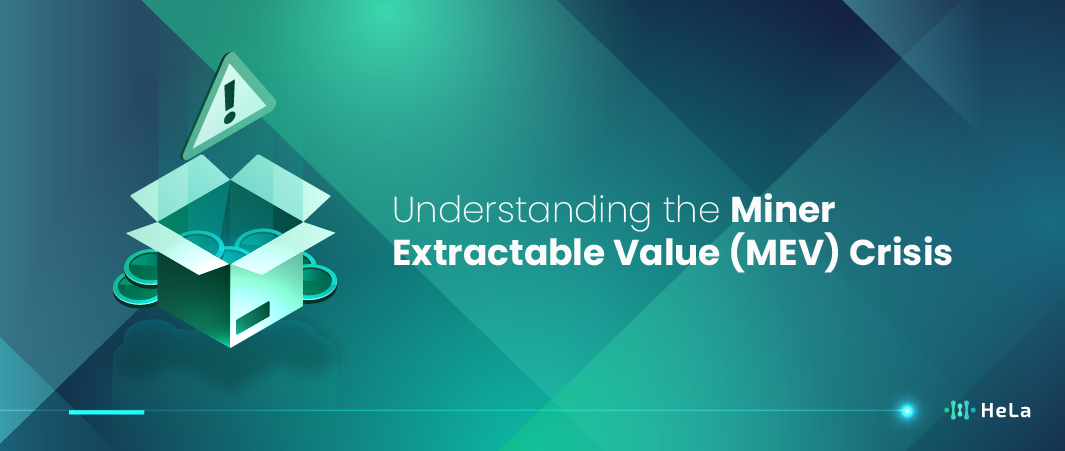The fundamental problem of the MEV crisis is that there is an opportunity that miners or validators can rake in by gaming with the ordering of transactions we are adding to the block. By taking into consideration several factors together, mainly those related to miners who have power in transaction logarithm, the complexity of smart contract iterations, Ethereum’s fee market design, and the lack of transparency in transaction operations management, we can conclude that scalability is a disputed one. These features influence the MEV extraction environment and then let miners find opportunities for economic rewards, exploiting the vulnerabilities of the blockchain infrastructure for personal gain.
In this paper, the broad discussion of the MEV dilemma will include the defining factors, its origins, signs and effects, and promising ways to solve it. We analyze approaches where miners select transactions to get maximum profit and mechanisms when smart-contracts work in such a way that opportunities to extract MEV grow a great deal. The second is a fee market design in which the platform owns the opportunities to make use of them. Also, we discuss the consequences of this crisis for all stakeholders within the blockchain citizenry, such as end users, developers, miners, and regulators.
What is causing the MEV Crisis?

The issue of potential MEV (Mining Extractable Value) has become an intricate and constantly changing problem that exists within the blockchains, with the Ethereum platform being one of the most vivid examples. Indeed, on a fundamental level, MEV relates to the advantage that miners or validators might take by changing the transaction ordering or life cycle in blocks. This phenomenon involved quite a few factors that also interacted with each other in such a way that the blockchain infrastructure was exploited in terms of the economic motivations and weaknesses of the system, namely.
The emergence of mining power as the main factor in the MEV crisis is usually due to the control that mining possesses over transaction ordering. Miners consider the transaction fee as well as the opportunity to arbitrage the moment they choose a transaction to include it in a new block. The miner’s ability to choose the longest chain allows them to maximize their gains by selecting the most expensive transactions or by taking advantage of DeFi’s price discrepancies (decentralized finance) systems, where they can leverage the platform differences in arbitrage.
On top of many MEV opportunities, smart contract interactions pose another problem that intensifies the MEV problem. DeFi protocols, which are often intricate contracts in the background, create MEV crisis extraction capable settings both at different times and at the same time. Miners are able to feast on the ambiguities of these interactions and reap the rewards to their benefit with transactions designed not only to pay them in their full amount but to take away from other users who may have had other transactions in mind. They can be exemplified by the frontrunning of trades and sandwich attacks, as well as other shortcomings that talk about delays or a change in the order of deals within blocks.
Also Read: Top 5 Layer 1 Crypto Projects Stand as Pillars of Innovation in 2023
Resolving the MEV dilemma involves a myriad of methods, which shouldn’t only be limited to the technical approaches but the economic ones too. Several blockchain projects are thoughtfully exploring different means of rebalancing the equation of MEV crisis extraction, and they include fee market reforms, improved transparency and network-embedded mitigations. Still, one will realize that this task will be accomplished only with the consistent engagement and innovation of the blockchain network operators aimed at creating reliable and stable crypto platforms.
Implications of the MEV Crisis

The MEV (Multimedia Entertainment Value) crisis imposes heavy consequences upon multiple chains of this ecosystem, beginning with users, developers, and miners and ending with the whole DeFi world. Knowing the ramifications of MEV crisis extraction is extremely significant for the realization of all the clarity that such a process can have on the efficiency, integrity, and security concerns of decentralized networks.
User Vulnerability
MetGas Extraction, which is based on classification, profit-making schemes, and high-performance computing power, influences the DeFi application users, who mostly use blockchain networks. MEV is represented in different ways, for example, by deploying front-running trades that allow miners to move ahead of others for the benefit of the miners to profit. This may in turn result in unswift or unnatural trade executions, which cost users their money or potential profit.
MEV also facilitates the possibility of arbitrage, which occurs when miners take advantage of price disparities across different exchanges, thereby making ordinary users the losers. In addition, transaction censorship, where miners starve or push out a transaction based on their own personal or economic interests, adversely affects the fair and timely completion of a decentralized application. Essentially, MEV creates an additional risk of unpredictability and distrust in DeFi ecosystems, which point up the necessity of measures aimed at reducing the volatility of the market and protecting users’ interests.
Market Inefficiency
The presence of MEV in blockchain trading markets, however, leads to the creation of circuitous processes that disrupt stock openness and honest market competition. The potential for manipulation is cause for concern on the part of market participants in view of the fact that miners wield the power of predetermined access to transaction data to the detriment of other participants.
It tends to have negative consequences for auction mechanisms, such as artificially inflated prices, uneven competition, and a decrease in the trading volumes of decentralized exchanges, leading to impaired madness and efficiency. In addition, the darkness of energy may stir up coves in the blockchain marketplace with MEV traders in the market who are in a bid to predict and possibly bar the departure to the current driven by MEV price movements. These ineffable stents erode trust in the cryptography ecosystem, leading potential users and investors to shun blockchain technologies, thus hindering the growth and adoption of these technologies. Due to MEV exploitation, we need to bring a new market design that focuses on transparency, fairness and market integrity.
Protocol Security
The risks of MEV can be increased security-wise for blockchain protocols with uncommon principles of smart contracts and complicated interactions. The vulnerabilities in a smart contract or protocol design can be exploited by a miner to extract value, which is made possible by spending money and network disruption. For instance, miners in bad faith can tamper with the transaction ordering system to make unauthorized transactions or use the loophole in the operation of decentralized applications to get money away from users.
Similarly, MEV-instituted attacks, like sandwich attacks and frontrunning, may be able to gain advantage from the design weaknesses of a protocol and can be further used for manipulation of the market price or harming the integrity of decentralized exchanges. These security risks manifest themselves in the development of more robust security measures, carrying out thorough code audits, and implementing protocol improvements to contain and make the MEV crisis extraction effect less damaging to the blockchain networks.
Network Centralization
MEV crisis extraction power can be largely concentrated in a few mining and validating nodes. This scenario might lead the network to centralization, weakening the core principles of decentralization on which blockchain principles are based. Given that miners with massive computation power and sometimes privileged access to a record of transactions may dominate the process of transaction validation and block production. They can become the most expensive and powerful class in the network. In addition to the risks of collusion, manipulation and censorship by a small group of players.
It’s hard to imagine decentralized networks being resilient and censorship-resistant in an environment where power is concentrated in the hands of a small group of actors. Lastly, probably, centralization of networks can bring about greater system risks since a single weakness or bad actor can damage an entire network. To deal with the risk of network centralization caused by MEV crisis extraction, it is of great importance to give weight to the power balance of network nodes by guaranteeing more diversity and regulatory supervision among miner and validator nodes, which in turn give rise to security, resilience, and censorship invulnerability in blockchains.
Regulatory Scrutiny
The MEV phenomenon and its consequences for market fairness, as well as the investor’s protection regulations, may create the legal authorities’ reactions and even the legislators’ interference. The authorities could focus on the above mentioned matters, which involve market manipulation, insider trading and the aspect of unfair competition in the crypto-finance world. This could lead to the establishment of regulatory frameworks or administrative measures aimed at reducing the risks of disruption of market transparency and integrity as a result of MEV developers and market participants.
Although monetary interventions in the blockchain space need to find the equilibrium factor between promoting innovation and protecting investors, overdoing would only halt the process of technological development while hindering ecosystem development related to decentralized finance at the same time. The involvement of industry stakeholders and regulators in a collaborative engagement setup is critical and necessary for the development of regulatory structures that accommodate innovation and investors’ protection while at the same time promoting market stability. This is due to emerging challenges such as the MEV extortion.
Addressing the MEV Crisis

Addressing the MEV (Miner Extractable Value) crisis requires a multifaceted approach that involves collaboration and innovation across various stakeholders within the blockchain ecosystem. Several strategies and solutions have been proposed to mitigate the impact of MEV crisis extraction and enhance the resilience, fairness, and efficiency of decentralized networks.
Fee Market Reforms
Market fee changes are the adoption of new methods for setting and ensuring the processing of transaction fees by the blockchain networks. That can be done through an analysis of various alternative charging models, such as fixed bidding or a certain expiration after some time, to decrease the congestion problem and neutralize the MEV motivators. The intention of deploying a more effective design of fees from the market: overwhelmingly improve the equity, intelligibility and affordability of the operations of payment for users.
For example, the planned transition of Ethereum from Eth 1.0 to Eth 2.0, featuring the PoS consensus mechanism and sharding architecture, strives to resolve scalability difficulties and decrease transaction fees, resulting in a lower BME extraction impact on the network throughput and the overall user experience. Furthermore, the development of fee computation algorithms with improved functions and gas-price-based techniques for optimization of block processing is intended to help minimize the prospects for MEV exploitation by reducing the volatility of fees and promoting fair access to block space for every coin owner.
Transparency Enhancements
The increase in transparency in transaction ordering and execution is one of the basic mechanisms that helps in detecting and avoiding MEV manipulation. Blockchain projects, meanwhile, are imagining and implementing many techniques to bolster transparency, such as transaction privacy technologies, blockchain explorer tool upgrades, and establishing tracking and analysis means, as the reaction to MEV could be rather undesirable.
For one, transactions can be monitored by projects like Flashbots that provide visibility into transaction sequencing and MEV crisis extraction, which would enable users to watch and analyze the MEV behavior right on-chain. By giving users more of a say when it comes to monitoring their dealings and decision-making capabilities within a distributed network, blockchain technology can reduce the number of cases of mistrust and unaccountability. Furthermore, the progress in zero knowledge proof and data privacy related technologies provides exciting directions for privacy protection in operations and also aids in the evolution of secure, reliable and convincing finance.
Protocol-Level Mitigations
The modernization level of solutions consists of improvements and solutions at the protocol level of the blockchain and tends to solve the root of the MEV problem, which makes DSNs more secure and robust. This includes the arrangement of ordering transactions algorism, decreasing transaction executive time, and increasing MEV crisis extraction incentive. As an illustration, EIPs like EIP-1559 which captures in the Ethereum market the fundamental way of calculating the fees and aims to enhance the predictability of the fees and block the negative effects of the MEV crisis extraction on network congestion, introduce a base fee mechanism.
Researchers’ main concern is consensus actuations, including but not limited to proof-of-stake and delegated proof-of-stake, and these consensus actuations purport to diminish the centrality of miners and at the same time enhance the networks’ security and scalability. Through this process, blockchain projects can uplift lower levels that are facing protocol-related vulnerabilities and susceptibilities and thereby make participation in the decentralized network safe and fluid for all the participants, thus bringing everything together in one harmonious financial ecosystem.
Community Collaboration
Community commitment becomes even more necessary in terms of pushing innovation and providing long term solutions to mitigate the negative effects of the information vacuum. Ongoing informative discussion among blockchain developers, researchers, miners, and users allows key players to pinpoint the ideal solution and contribute to it by seeking, sharing, and implementing the best practices for preventing MEV amassing.
An example could be initiatives like MEV-Research and Flashbots, which provide insightful collaboration among researchers, developers and miners to determine and describe the effect of MEV on the blockchain environment. Moreover, people are offered chances to propose resolutions, share experiences, and join efforts in solving and lessening the negative effects of MEV crisis extraction on decentralized networks by arranging hackathons, workshops, and collaborative projects. Through developing a collaborative and cooperative community culture, blockchain projects have the possibility of taking advantage of the collective intelligence and greatness the community has in the MEV crisis resolution and responding to decentralized financial systems.
Also Read: Top 10 Fastest Blockchain Platforms in 2024
Regulatory Considerations
Regulatory interventions may have an impact on MEV cases as well, by addressing market integrity, investor protection, and anti-competitive behavior. Policymakers may strive to put in place regulations or rules that will safeguard the risks around MEV crisis extraction and, by the same token, promote decentralized finance eco-systems thus making them transparent, accountable and trust worthy.
Particularly, powerful bodies such as the SEC and the CFTC will develop guidelines for marketplaces to warn MEV-related risks and may also impose regulations on participants to make sure they can’t take advantage of the investors. While regulatory measures are indispensable, they must be carefully designed so that even handshakes with consumer protection are ensured and both innovation and competition in the block chain field gain momentum Collaboration among regulators, industry stakeholders, and government participants is fundamental in this process to develop a regulatory system that will maintain a fair market for investors and will allow the industry to be adopted with due diligence amid challenges from the newly emerging market, such as MEV crisis extraction.
Conclusion
The phenomenon of MEV, or miner extractable value crisis, is a serious issue that has gained prominence in blockchain ecosystems (an example being Ethereum). Be that as it may, this dilemma is issued by the combination of these factors: miners’ (rendering) command over the transaction arrival chronology, the high complexity and special traits of smart contracts, the feeling market design of Ethereum, and the absence of the transparency that hosts the transactions. To tackle the MEV problem, the key choices are reforms in the fee market, improvement of transparency, mitigation protocols, community collaboration and consideration of what the law requires us to do.
The fee laws are conceived to harmonize the transaction fee architecture in order to deal with the issues of congestion and discourage the act of MEV crisis extraction. Transparency additions may include the provision of infrastructure for access to the background queue and the input submissions, thereby giving users the opportunity to realize MEV activities. The effort of mitigations at the protocol-level is to strengthen the foundations of protocols to consider and address those holey points and reduce the space for MEV exploitation. Collaboration by the community in this respect encourages innovation and progress by putting it together through open conversations, the exchange of knowledge, and joint activities. The issue of policy entails creating models that promote fairness on the platform and allow room for innovation and competition in the blockchain world.
Disclaimer: The information provided by HeLa Labs in this article is intended for general informational purposes and does not reflect the company’s opinion. It is not intended as investment advice or a recommendation. Readers are strongly advised to conduct their own thorough research and consult with a qualified financial advisor before making any financial decisions.

In the role of a Hela writer, I weave stories that reveal the core of this revolutionary Layer-1 solution. Created in partnership with accomplished engineers, scientists, and A*STAR IHPC, Hela is tailored for real-world use
- Alifia Berizkyhttps://helalabs.com/blog/author/alifiabm/
- Alifia Berizkyhttps://helalabs.com/blog/author/alifiabm/
- Alifia Berizkyhttps://helalabs.com/blog/author/alifiabm/
- Alifia Berizkyhttps://helalabs.com/blog/author/alifiabm/

